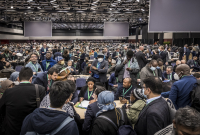As early as the 1970s, the authors of The Club of Rome — an informal organization of intellectuals and business leaders whose goal is a critical discussion of pressing global issues — were calling attention to the limits of growth, and impossibility of infinite growth in a world with finite resources. Fifty years later, the exceeding of six of the nine planetary limits requires us to change trajectory, and therefore, our economic model.
However, one of the obstacles to this necessary transformative change is that it is still perceived by many as a return to living in caves.
But what would that cave actually look like? Julia Steinberger, professor of ecological economics at the University of Lausanne and an expert at the U.N.’s Intergovernmental Panel on Climate Change (IPCC), addressed this question.
Her team’s model demonstrated that every person could live in a household that could be heated or cooled to 20°C in summer or winter, and have a fridge, oven and dishwasher. Each individual could have Wi-Fi and a cell phone with data. A household could acquire the equivalent of 4 kg of clothing per year, and people in rural areas could drive 15,000 km per year.
Material consumption in Canada is among the highest in the world per capita (35 tonnes extracted per capita per year, compared to 19 in Europe, and 12.5 around the globe). How can we make a change?
This is the question that we asked with the Montreal Call initiative at COP15 on biodiversity, held in Montreal in 2022. We intend to ask this question again at COP16 in Colombia in October.
Systemic changes are needed to address biodiversity loss
The findings and recommendations from the U.N.’s Intergovernmental Science-Policy Platform on Biodiversity and Ecosystems Services (IPBES) scientists are clear. We must not only address the direct causes of biodiversity loss, such as habitat loss and pollution, but also the political, economic and social factors that cause our societies to overexploit nature.
The underlying causes identified by scientists include extracting and processing natural resources, expanding international trade, as well as growing consumption per capita and technological innovation.
How should we change our economies so they stay within planetary boundaries? What values in our society are compatible with biodiversity conservation?
The Montreal Call is an invitation to discuss these questions. It’s endorsed by the City of Montreal, the governments of Quebec, Canada and the Cree Nation, and dozens of other organizations.
Possible solutions to stop destroying nature
- Ban ads for products that harm the environment
Advertising associates buying with pleasure and happiness, and is a powerful economic driver intended to continuously increase supply and demand. This model, however, ignores the limits of our world’s resources by encouraging excessive consumption. Canadians alone would require five Earths to sustain their resource consumption every year.
Ads for guns and tobacco are banned, so if we take biodiversity and the climate crisis seriously, shouldn’t we ban ads for other products that harm the environment?
In Europe, the city of Utrecht, Netherlands, recently banned meat, dairy and air travel ads. In Lyon, France, a new regulation bans digital advertising screens in public spaces.
- Build alliances with other species
The Fish & Wildlife Service in the United States recently published a guidebook on beaver restoration entitled, Working with Beaver to Restore Streams, Wetlands, and Floodplains.
Beavers help maintain better groundwater levels because their dams slow down the flow of water and retain sediment. The presence of beavers reduces the risk of flooding, improves the quality of the water and promotes greater diversity of fauna and flora.
There are now dozens of beaver restoration projects in the U.S., which include re-establishing beaver populations in river valleys and replicating the techniques used by beavers.
- Prioritize low-tech
New technologies can help improve human well-being, but we shouldn’t forget that they increase material consumption, which adds pressure to ecosystems and generates immense amounts of e-waste.
Born in response to technological solutionism, the low-tech approach is not a refusal to use technology but rather an invitation to use it mindfully. Examples of low-tech solutions range from solar ovens to compressed-air energy storage systems and passive solar greenhouses. But the low-tech approach goes beyond DIY projects and can make a difference in how we live in our communities.
As the logistics industry waits to see whether drone delivery will take off, electric and non-electric cargo bike delivery is rolling forward and having major effects on urban logistics. In Montreal, various pilot projects are underway to add urban warehouses (mini-hubs), and increase efforts to remove snow from bike lanes during the winter. In short, low-tech makes it possible to imagine cities that are both smart and more energy-efficient.
Plenty of solutions already exist, like laws that promote the rights of nature, complementary local currencies, and wellness budgets — they just need to be implemented.
From Montreal to Cali
COP16 will be held in Cali, Colombia, at the end of October. It will be the first COP to implement the new Global Biodiversity Framework, and all countries will be invited to present their action plans to meet the 2030 targets.
A good foundation is an essential step to bring the dialogue about solutions to the underlying causes of biodiversity loss to the highest level. All stakeholders must be committed to making transformative changes.
We’re hoping to see a lot of responses to the Montreal Call, all the way from Ottawa to Cali.
Alain Branchaud is a biologist and executive director of SNAP Quebec.
Alice de Swarte is strategic advisor at SNAP Québec, promoting the Montreal Call to operate transformative change for biodiversity.







Comments